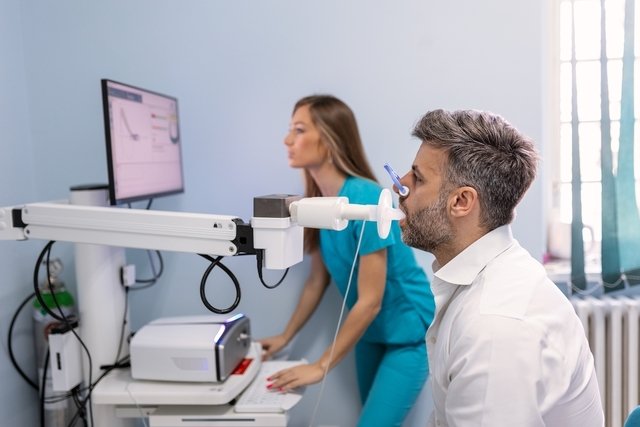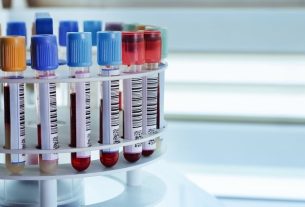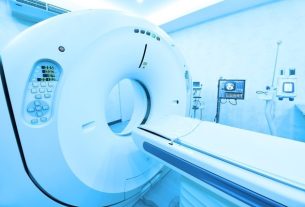Spirometry is a lung function test recommended by a pulmonologist to diagnose respiratory problems, such as chronic obstructive pulmonary disease (COPD), asthma, pulmonary emphysema or chronic bronchitis.
This exam allows the doctor to evaluate respiratory volumes, that is, the amount of air that enters and leaves the lungs, as well as the flow and time, being considered the most important exam to evaluate lung function.
The spirometry test can be done free of charge by the SUS, or carried out in private clinics or hospitals, and the results must be interpreted by the pulmonologist, along with other tests that evaluate the lungs.

What is it for
The spirometry test is indicated to help diagnose respiratory problems, such as:
- Asma;
- Chronic obstructive pulmonary disease (COPD);
- Chronic bronchitis;
- Pulmonary emphysema;
- Pulmonary fibrosis or cystic fibrosis.
In addition, the pulmonologist may also recommend carrying out spirometry as a way of monitoring the patient’s progress with respiratory diseases, being able to check whether they are responding well to treatment and, if not, may indicate another form of treatment.
In the case of high-performance athletes, such as marathon runners and triathletes, for example, the doctor may recommend spirometry to assess the athlete’s respiratory capacity and, in some cases, provide information to improve the athlete’s performance.
Schedule an evaluation with a pulmonologist in the nearest region:
Taking care of your health has never been easier!
How to prepare for the exam
Preparing to take the spirometry test is very simple, and includes:
- Do not smoke or drink alcohol 24 hours before of the exam;
- Avoid heavy or intense physical exercise before the exam;
- Avoid eating a very heavy meal before the exam;
- Wear comfortable clothes and a little tight.
This preparation prevents lung capacity from being affected by factors other than a possible disease. Therefore, if there is no adequate preparation, it is possible that the results will be altered, and it may be necessary to repeat the spirometry.
How it is made
Spirometry is a simple and quick test, lasting an average of 15 minutes, carried out by a pulmonologist in specialized clinics or hospitals.
To begin the exam, the person must be seated and a nose clip is placed on their nose to keep their nostrils closed and allow them to breathe only through their mouth.
The person is then asked to inhale deeply, place their mouth on the disposable mouthpiece of the spirometry device, and exhale the air from their lungs as hard as possible, for about 6 seconds, without interruption.
This procedure must be repeated 3 times, it is important to ensure that the lips are well positioned on the mouthpiece to seal it and prevent air from escaping.
After this first step, the doctor may also ask the person to use a bronchodilator medicine, which dilates the bronchi and facilitates breathing, and blows into the device again. This way you can check whether there is an increase in the amount of air inspired after using the medicine.
During this entire process, a computer records all the data obtained through the exam so that the doctor can evaluate it later.
How to interpret the result
Spirometry values vary according to the person’s age, sex and size and, therefore, must always be interpreted by the doctor. However, normally, right after the spirometry test, the doctor already makes some interpretation of the results and informs the patient if there is a problem.
Typically, spirometry results that indicate respiratory problems are:
- Forced expiratory volume (FEV1 or FEV1): represents the amount of air that can be exhaled quickly in 1 second and, therefore, when it is below normal it can indicate the presence of asthma or COPD;
- Forced vital capacity (VCF or FVC): is the total amount of air that can be exhaled in the shortest possible time and, when it is lower than normal, it can indicate the presence of lung diseases that make lung expansion difficult, such as cystic fibrosis, for example.
Generally, if a person presents altered spirometry results, it is common for the pulmonologist to request a new spirometry test to assess respiratory volumes after taking an asthma inhaler, for example, to assess the degree of the disease and initiate the most appropriate treatment.
Possible risks of the exam
The spirometry test is considered safe, but in some cases, it is possible for the person to feel dizzy, nausea, cough, weakness, tremor or tiredness after the test, lasting for a short time.
Who shouldn’t do
Despite being a safe test, spirometry is contraindicated in the following cases:
- Recent unstable angina;
- Recent heart attack or acute coronary syndrome;
- Uncontrolled high blood pressure or intracranial hypertension;
- Retinal detachment;
- Recent respiratory infection or pneumothorax;
- Pulmonary embolism;
- Thoracic aortic aneurysm.
Furthermore, spirometry should not be performed in cases of recent surgery on the chest, brain, eyes, ears, nose, throat or stomach, as the test leads to an increase in pressure in these organs when air is exhaled into the device.
Bibliography
- LOPES, A.J. Advances in spirometry testing for lung function analysis. Expert Rev Respir Med. 13. 6; 559-569, 2019
- LAMB, K.; THEODORE, D.; BHUTTA, B. S. IN: STATPEARLS (INTERNET). TREASURE ISLAND (FL): STATPEARLS PUBLISHING. Spirometry. 2023. Available at: <https://www.ncbi.nlm.nih.gov/books/NBK560526/>. Accessed on May 17, 2023
- LANGAN, R. C.; GOODBRED, A. J. Office Spirometry: Indications and Interpretation. Am Fam Physician. 101. 6; 362-368, 2020
- RIVERO-YEVERINO, D. Spirometry: basic concepts. Rev Alerg Mex. 66. 1; 76-84, 2019

Sign up for our newsletter and stay up to date with exclusive news
that can transform your routine!
Warning: Undefined array key "title" in /home/storelat/public_html/wp-content/plugins/link-whisper-premium/templates/frontend/related-posts.php on line 12
Warning: Undefined array key "title_tag" in /home/storelat/public_html/wp-content/plugins/link-whisper-premium/templates/frontend/related-posts.php on line 13



